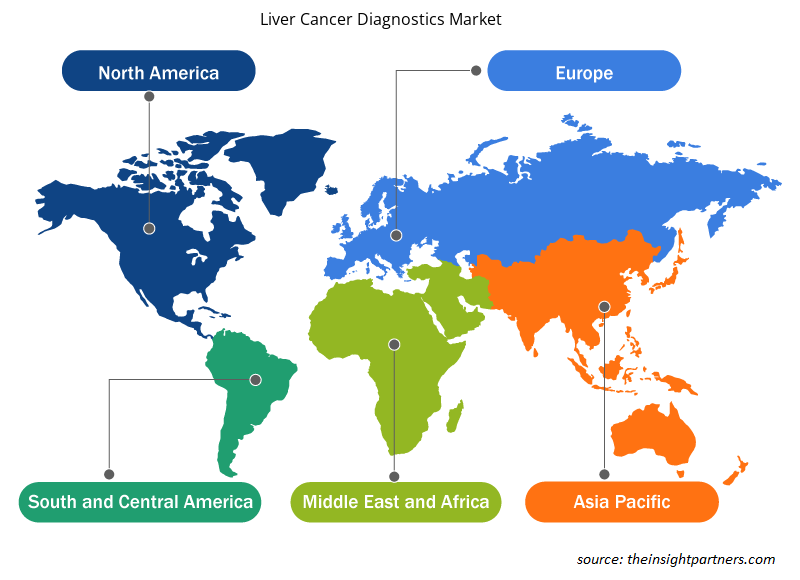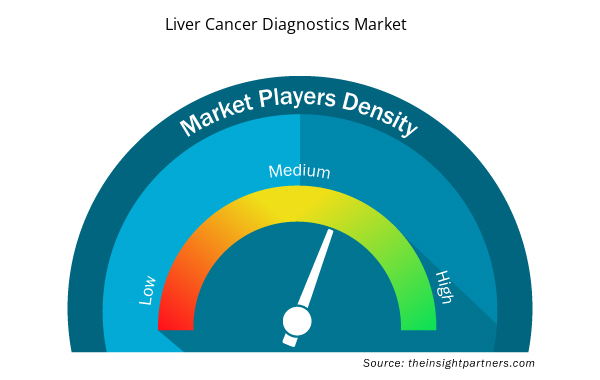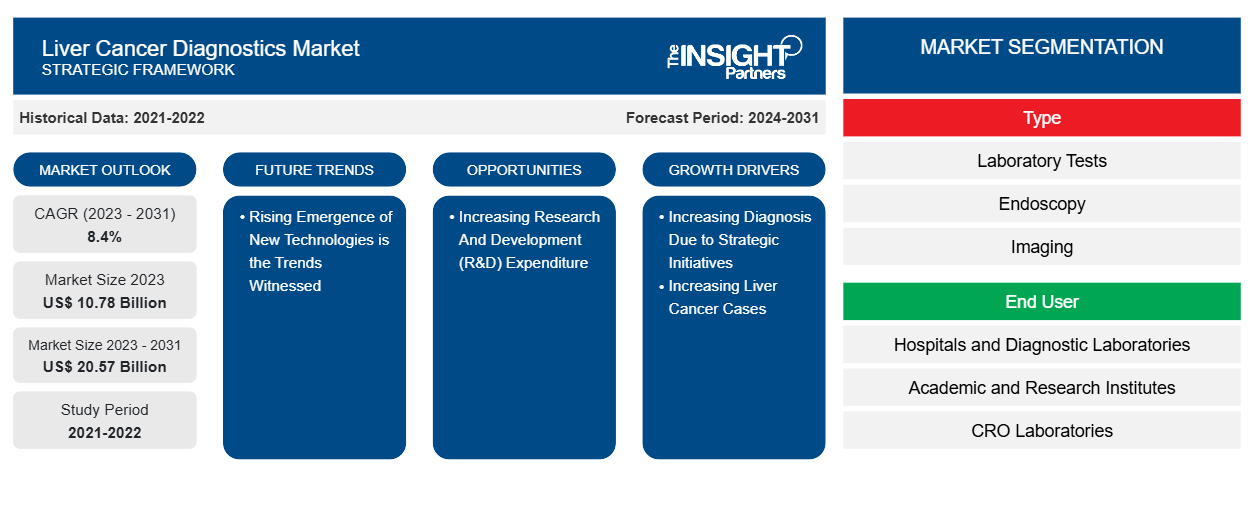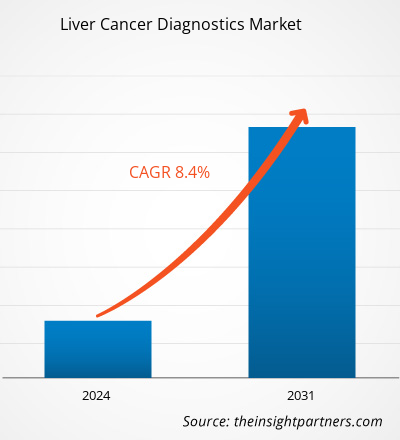Der Markt für Leberkrebsdiagnostik soll von 10,78 Milliarden US-Dollar im Jahr 2023 auf 20,57 Milliarden US-Dollar im Jahr 2031 anwachsen. Der Markt wird zwischen 2023 und 2031 voraussichtlich eine durchschnittliche jährliche Wachstumsrate von 8,4 % verzeichnen. Die zunehmende Entwicklung neuer Technologien dürfte ein wichtiger Trend auf dem Markt bleiben.
Marktanalyse für Leberkrebsdiagnostik
Laut CDC erkranken in den Vereinigten Staaten jedes Jahr etwa 24.500 Männer und 10.000 Frauen an Leberkrebs, von denen 18.600 Männer und 9.000 Frauen an der Krankheit sterben. Die Zahl der Fälle von Leberkrebs in den USA steigt seit mehreren Jahrzehnten. Das hepatozelluläre Karzinom (HCC) ist die häufigste Leberkrebsart in den USA. Darüber hinaus leidet laut der kanadischen Regierung derzeit etwa jeder vierte kanadische Erwachsene (26,6 %) an Fettleibigkeit. Auch die Zahl der Fälle von Fettleibigkeit nimmt zu und mit der Zunahme der Fälle steigt auch das Risiko bestimmter gesundheitlicher Probleme wie Leberschäden, Diabetes, Bluthochdruck und Herzerkrankungen.
Marktübersicht zur Leberkrebsdiagnostik
Im Jahr 2020 gab die Weltgesundheitsorganisation (WHO) an, dass es weltweit über 10 Millionen Todesfälle gab, von denen jeder sechste auf Krebs zurückzuführen ist. Darüber hinaus war Leberkrebs im Jahr 2020 eine der häufigsten Krebsarten und machte etwa 4,7 % aller neuen Krebsfälle und 8,3 % aller Krebstodesfälle aus. 75 bis 90 % aller diagnostizierten Leberkrebsfälle sind hepatozelluläres Karzinom (HCC), das einen größeren Einfluss auf die krebsbedingten Todesfälle hat. Laut einem veröffentlichten Artikel in CCO (Chinese Clinical Oncology) ist hepatozelluläres Karzinom (HCC) eine der häufigsten Krebstodesursachen weltweit. Die am häufigsten verwendeten Verfahren zum HCC-Screening sind der Serum-Alpha-Fetoprotein-Test (AFP) und der Leber-Ultraschall. Gemessen an der Sensitivität hat der AFP-Test jedoch eine Sensitivität von 25 bis 65 % und der Ultraschall eine Sensitivität von über 60 %. Leberkrebs ist eine häufigere Krebsart, und die Fälle nehmen zu. So wird beispielsweise erwartet, dass die Sterberate durch HCC in Großbritannien bis 2025 um 14 % steigen wird. Das wäre der stärkste Anstieg bei allen Krebsarten.
Passen Sie diesen Bericht Ihren Anforderungen an
Sie erhalten kostenlos individuelle Anpassungen an jedem Bericht, einschließlich Teilen dieses Berichts oder einer Analyse auf Länderebene, eines Excel-Datenpakets sowie tolle Angebote und Rabatte für Start-ups und Universitäten.
- Holen Sie sich die wichtigsten Markttrends aus diesem Bericht.Dieses KOSTENLOSE Beispiel umfasst eine Datenanalyse von Markttrends bis hin zu Schätzungen und Prognosen.
Treiber und Chancen des Marktes für Leberkrebsdiagnostik
Zunehmende Diagnose aufgrund strategischer Initiativen zur Förderung des Marktes
Im Juni 2020 entwickelten Wissenschaftler des NCI einen neuen Test zur Früherkennung von Leberzellkarzinomen (HCC), der häufigsten Form von Leberkrebs. Bei diesem Screening wird eine Blutuntersuchung durchgeführt, um zu untersuchen, ob der Patient zuvor bestimmten Viren ausgesetzt war. Ein solches Screening ermöglicht eine frühzeitige Erkennung und Diagnose, vor allem weil Krebserkrankungen erst im Spätstadium oder fortgeschrittenen Stadium erkannt werden, das dann oft unheilbar ist. Darüber hinaus startete das NCI das CCR Liver Cancer Program, um neue Methoden zur Früherkennung, Diagnose und Behandlung zu entwickeln, mit dem Ziel, die Prognose von HCC-Patienten zu verbessern. Darüber hinaus starteten die National Institutes of Health (NIH) ihr Netzwerk für klinische Studien, um mögliche Vorteile und Probleme vielversprechender neuer Krebs-Screening-Technologien zu bewerten und die effizientesten Methoden zur Integration dieser Innovationen in Standardbehandlungsprotokolle zu ermitteln.
Steigende Ausgaben für Forschung und Entwicklung (F&E)
Im Jahr 2021 beliefen sich die Forschungs- und Entwicklungsausgaben (F&E) von Elecsys GALAD auf 14,65 Milliarden US-Dollar und im Jahr 2020 auf 13,17 Milliarden US-Dollar. Auf Kernbasis sind sie um 14 % gestiegen. Darüber hinaus sind die F&E-Ausgaben von F. Hoffmann-La Roche Ltd. vor allem für Investitionen in die Spätphase der Onkologie, Augenheilkunde und personalisierte Gesundheitsfürsorge gestiegen. Darüber hinaus führten Wissenschaftler der National Institutes of Health (NIH) im Juni 2020 Bluttests zur Verbesserung der Leberkrebsvorsorge ein, die von Forschern des National Cancer Institute (NCI) verwaltet werden. Daher treiben die steigenden F&E-Investitionen und die Entwicklung von Diagnosetests für Leberkrebs den Markt für Leberkrebsdiagnostik an.
Segmentierungsanalyse des Marktberichts zur Leberkrebsdiagnostik
Wichtige Segmente, die zur Ableitung der Marktanalyse für Leberkrebsdiagnostik beigetragen haben, sind Typ und Endbenutzer.
- Nach Typ ist der Markt in Labortests, Endoskopie , Bildgebung, Biopsie und andere unterteilt. Das Segment Labortests hatte im Jahr 2023 einen größeren Marktanteil.
- Basierend auf dem Endverbraucher ist der Markt in Krankenhäuser und Diagnoselabore, akademische und Forschungsinstitute sowie CRO-Labore unterteilt. Das Segment Krankenhäuser und Diagnoselabore hatte im Jahr 2023 einen größeren Marktanteil.
Marktanteilsanalyse für Leberkrebsdiagnostik nach geografischer Lage
Der geografische Umfang des Marktberichts zur Leberkrebsdiagnostik ist hauptsächlich in fünf Regionen unterteilt: Nordamerika, Asien-Pazifik, Europa, Naher Osten und Afrika sowie Süd- und Mittelamerika.
Nordamerika dominiert den Markt und der asiatisch-pazifische Raum wird in den kommenden Jahren voraussichtlich die höchste durchschnittliche jährliche Wachstumsrate aufweisen. Das Wachstum des asiatisch-pazifischen Marktes ist auf die steigende Zahl älterer Menschen und die zunehmenden Behandlungsmöglichkeiten für Leberkrebs zurückzuführen. Aufgrund der Einführung verbesserter Diagnoseverfahren für Leberkrebs in Ländern wie Indien und China wird für die Region Asien-Pazifik die höchste durchschnittliche jährliche Wachstumsrate erwartet. Da sich die Kosteneffizienz von Diagnoselösungen verbessert, wird die Nachfrage nach Leberkrebsdiagnostik in unabhängigen Diagnoselabors im asiatisch-pazifischen Raum voraussichtlich steigen. Die oben genannten Faktoren werden den Markt für Leberkrebsdiagnostik vorantreiben.
Regionale Einblicke in den Markt für Leberkrebsdiagnostik
Die regionalen Trends und Faktoren, die den Markt für Leberkrebsdiagnostik im Prognosezeitraum beeinflussen, wurden von den Analysten von Insight Partners ausführlich erläutert. In diesem Abschnitt werden auch die Marktsegmente und die Geografie der Leberkrebsdiagnostik in Nordamerika, Europa, im asiatisch-pazifischen Raum, im Nahen Osten und Afrika sowie in Süd- und Mittelamerika erörtert.

- Erhalten Sie regionale Daten zum Markt für Leberkrebsdiagnostik
Umfang des Marktberichts zur Leberkrebsdiagnostik
| Berichtsattribut | Details |
|---|---|
| Marktgröße im Jahr 2023 | 10,78 Milliarden US-Dollar |
| Marktgröße bis 2031 | 20,57 Milliarden US-Dollar |
| Globale CAGR (2023 - 2031) | 8,4 % |
| Historische Daten | 2021-2022 |
| Prognosezeitraum | 2024–2031 |
| Abgedeckte Segmente | Nach Typ
|
| Abgedeckte Regionen und Länder | Nordamerika
|
| Marktführer und wichtige Unternehmensprofile |
|
Marktteilnehmerdichte im Bereich Leberkrebsdiagnostik: Auswirkungen auf die Geschäftsdynamik verstehen
Der Markt für Leberkrebsdiagnostik wächst rasant, angetrieben durch die steigende Nachfrage der Endnutzer aufgrund von Faktoren wie sich entwickelnden Verbraucherpräferenzen, technologischen Fortschritten und einem größeren Bewusstsein für die Vorteile des Produkts. Mit steigender Nachfrage erweitern Unternehmen ihr Angebot, entwickeln Innovationen, um die Bedürfnisse der Verbraucher zu erfüllen, und nutzen neue Trends, was das Marktwachstum weiter ankurbelt.
Die Marktteilnehmerdichte bezieht sich auf die Verteilung der Firmen oder Unternehmen, die in einem bestimmten Markt oder einer bestimmten Branche tätig sind. Sie gibt an, wie viele Wettbewerber (Marktteilnehmer) in einem bestimmten Marktraum im Verhältnis zu seiner Größe oder seinem gesamten Marktwert präsent sind.
Die wichtigsten auf dem Markt für Leberkrebsdiagnostik tätigen Unternehmen sind:
- Abbott,
- BioMerieux SA,
- F. HOFFMANN-LA ROCHE LTD,
- Illumina, Inc.,
- Koninklijke Philips NV,
- QIAGEN,
Haftungsausschluss : Die oben aufgeführten Unternehmen sind nicht in einer bestimmten Reihenfolge aufgeführt.

- Überblick über die wichtigsten Akteure auf dem Markt für Leberkrebsdiagnostik
Neuigkeiten und aktuelle Entwicklungen zum Markt für Leberkrebsdiagnostik
Der Markt für Leberkrebsdiagnostik wird durch die Erhebung qualitativer und quantitativer Daten nach Primär- und Sekundärforschung bewertet, die wichtige Unternehmensveröffentlichungen, Verbandsdaten und Datenbanken umfasst. Nachfolgend sind einige der Entwicklungen auf dem Markt für Leberkrebsdiagnostik aufgeführt:
- Illumina, Inc. hat den onkologischen Test TruSight zur Beurteilung mehrerer Tumorgene und Biomarker auf den Markt gebracht. Der TruSight-Test wird in Kürze in Europa weltweit eingeführt. Er untersucht die Tumorgene und Biomarker, um das spezifische molekulare Profil des Krebses eines Patienten zu ermitteln und hilft so bei der Entscheidungsfindung in der Präzisionsmedizin. (Quelle: Illumina, Inc., Pressemitteilung, März 2022)
- Perspectum ist eine Partnerschaft mit HepQuant eingegangen, um die Bereitstellung der Leberfunktionsbewertungstechnologie von HepQuant über die Contract Research Organization (CRO)-Dienste von Perspectum zu ermöglichen. Diese Zusammenarbeit ermöglichte es Pharmaunternehmen, die klinische Studien zu Lebererkrankungen wie Leberzirrhose, nichtalkoholischer Steatohepatitis (NASH), Autoimmunlebererkrankungen und Leberkrebs durchführen, Bildgebungs- und Funktionstestkenntnisse von Perspectums Pharma Solutions zu erhalten. (Quelle: Perspectum, Pressemitteilung, November 2021)
Marktbericht zur Leberkrebsdiagnostik – Umfang und Ergebnisse
Der Bericht „Marktgröße und Prognose für Leberkrebsdiagnostik (2021–2031)“ bietet eine detaillierte Analyse des Marktes, die die folgenden Bereiche abdeckt:
- Marktgröße und Prognose für Leberkrebsdiagnostik auf globaler, regionaler und Länderebene für alle wichtigen Marktsegmente, die im Rahmen des Berichts abgedeckt sind
- Markttrends im Bereich Leberkrebsdiagnostik sowie Marktdynamik wie Treiber, Einschränkungen und wichtige Chancen
- Detaillierte PEST/Porters Five Forces- und SWOT-Analyse
- Marktanalyse für Leberkrebsdiagnostik mit Blick auf wichtige Markttrends, globale und regionale Rahmenbedingungen, wichtige Akteure, Vorschriften und aktuelle Marktentwicklungen3
- Branchenlandschaft und Wettbewerbsanalyse, die die Marktkonzentration, Heatmap-Analyse, prominente Akteure und aktuelle Entwicklungen auf dem Markt für Leberkrebsdiagnostik umfasst
- Detaillierte Firmenprofile
- Historische Analyse (2 Jahre), Basisjahr, Prognose (7 Jahre) mit CAGR
- PEST- und SWOT-Analyse
- Marktgröße Wert/Volumen – Global, Regional, Land
- Branche und Wettbewerbsumfeld
- Excel-Datensatz



Report Coverage
Revenue forecast, Company Analysis, Industry landscape, Growth factors, and Trends

Segment Covered
This text is related
to segments covered.

Regional Scope
North America, Europe, Asia Pacific, Middle East & Africa, South & Central America

Country Scope
This text is related
to country scope.
Häufig gestellte Fragen
North America has dominated the Liver Cancer Diagnostics market.
Factors such as increasing diagnosis due to strategic initiatives and incasering liver cancer cases will boost the market growth.
The rising emergence of new technologies is likely to remain a key trend in the market.
The liver cancer diagnostics market size is projected to reach US$ 20.57 billion by 2031.
The market is expected to register a CAGR of 8.4% during 2023–2031.
Trends and growth analysis reports related to Life Sciences : READ MORE..
The Insight Partners performs research in 4 major stages: Data Collection & Secondary Research, Primary Research, Data Analysis and Data Triangulation & Final Review.
- Data Collection and Secondary Research:
As a market research and consulting firm operating from a decade, we have published and advised several client across the globe. First step for any study will start with an assessment of currently available data and insights from existing reports. Further, historical and current market information is collected from Investor Presentations, Annual Reports, SEC Filings, etc., and other information related to company’s performance and market positioning are gathered from Paid Databases (Factiva, Hoovers, and Reuters) and various other publications available in public domain.
Several associations trade associates, technical forums, institutes, societies and organization are accessed to gain technical as well as market related insights through their publications such as research papers, blogs and press releases related to the studies are referred to get cues about the market. Further, white papers, journals, magazines, and other news articles published in last 3 years are scrutinized and analyzed to understand the current market trends.
- Primary Research:
The primarily interview analysis comprise of data obtained from industry participants interview and answers to survey questions gathered by in-house primary team.
For primary research, interviews are conducted with industry experts/CEOs/Marketing Managers/VPs/Subject Matter Experts from both demand and supply side to get a 360-degree view of the market. The primary team conducts several interviews based on the complexity of the markets to understand the various market trends and dynamics which makes research more credible and precise.
A typical research interview fulfils the following functions:
- Provides first-hand information on the market size, market trends, growth trends, competitive landscape, and outlook
- Validates and strengthens in-house secondary research findings
- Develops the analysis team’s expertise and market understanding
Primary research involves email interactions and telephone interviews for each market, category, segment, and sub-segment across geographies. The participants who typically take part in such a process include, but are not limited to:
- Industry participants: VPs, business development managers, market intelligence managers and national sales managers
- Outside experts: Valuation experts, research analysts and key opinion leaders specializing in the electronics and semiconductor industry.
Below is the breakup of our primary respondents by company, designation, and region:

Once we receive the confirmation from primary research sources or primary respondents, we finalize the base year market estimation and forecast the data as per the macroeconomic and microeconomic factors assessed during data collection.
- Data Analysis:
Once data is validated through both secondary as well as primary respondents, we finalize the market estimations by hypothesis formulation and factor analysis at regional and country level.
- Macro-Economic Factor Analysis:
We analyse macroeconomic indicators such the gross domestic product (GDP), increase in the demand for goods and services across industries, technological advancement, regional economic growth, governmental policies, the influence of COVID-19, PEST analysis, and other aspects. This analysis aids in setting benchmarks for various nations/regions and approximating market splits. Additionally, the general trend of the aforementioned components aid in determining the market's development possibilities.
- Country Level Data:
Various factors that are especially aligned to the country are taken into account to determine the market size for a certain area and country, including the presence of vendors, such as headquarters and offices, the country's GDP, demand patterns, and industry growth. To comprehend the market dynamics for the nation, a number of growth variables, inhibitors, application areas, and current market trends are researched. The aforementioned elements aid in determining the country's overall market's growth potential.
- Company Profile:
The “Table of Contents” is formulated by listing and analyzing more than 25 - 30 companies operating in the market ecosystem across geographies. However, we profile only 10 companies as a standard practice in our syndicate reports. These 10 companies comprise leading, emerging, and regional players. Nonetheless, our analysis is not restricted to the 10 listed companies, we also analyze other companies present in the market to develop a holistic view and understand the prevailing trends. The “Company Profiles” section in the report covers key facts, business description, products & services, financial information, SWOT analysis, and key developments. The financial information presented is extracted from the annual reports and official documents of the publicly listed companies. Upon collecting the information for the sections of respective companies, we verify them via various primary sources and then compile the data in respective company profiles. The company level information helps us in deriving the base number as well as in forecasting the market size.
- Developing Base Number:
Aggregation of sales statistics (2020-2022) and macro-economic factor, and other secondary and primary research insights are utilized to arrive at base number and related market shares for 2022. The data gaps are identified in this step and relevant market data is analyzed, collected from paid primary interviews or databases. On finalizing the base year market size, forecasts are developed on the basis of macro-economic, industry and market growth factors and company level analysis.
- Data Triangulation and Final Review:
The market findings and base year market size calculations are validated from supply as well as demand side. Demand side validations are based on macro-economic factor analysis and benchmarks for respective regions and countries. In case of supply side validations, revenues of major companies are estimated (in case not available) based on industry benchmark, approximate number of employees, product portfolio, and primary interviews revenues are gathered. Further revenue from target product/service segment is assessed to avoid overshooting of market statistics. In case of heavy deviations between supply and demand side values, all thes steps are repeated to achieve synchronization.
We follow an iterative model, wherein we share our research findings with Subject Matter Experts (SME’s) and Key Opinion Leaders (KOLs) until consensus view of the market is not formulated – this model negates any drastic deviation in the opinions of experts. Only validated and universally acceptable research findings are quoted in our reports.
We have important check points that we use to validate our research findings – which we call – data triangulation, where we validate the information, we generate from secondary sources with primary interviews and then we re-validate with our internal data bases and Subject matter experts. This comprehensive model enables us to deliver high quality, reliable data in shortest possible time.


 Holen Sie sich ein kostenloses Muster für diesen Bericht
Holen Sie sich ein kostenloses Muster für diesen Bericht